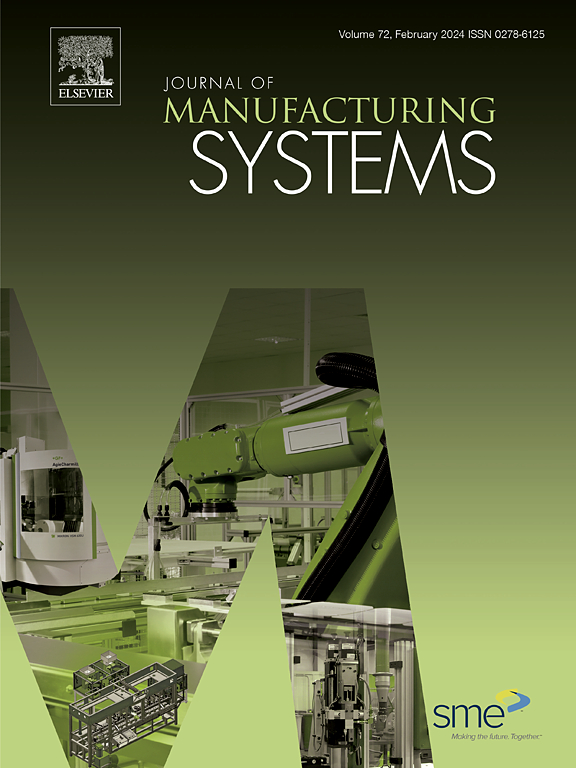通过微分几何和用于蚀刻缺陷检测的轻量级网络增强IC基板制造
IF 12.2
1区 工程技术
Q1 ENGINEERING, INDUSTRIAL
引用次数: 0
摘要
随着半导体制造中高密度互连技术的进步,集成电路(IC)衬底的精度和复杂性显著提高,对质量控制提出了更高的要求。复杂的蚀刻缺陷在制造过程中经常发生,高效准确的检测已成为防止潜在产品缺陷的关键。提出了一种结合轻量级网络和微分几何工具的缺陷检测方法,以解决集成电路衬底的蚀刻缺陷问题。首先,利用改进的可变形模型从复杂金相图像中快速提取规则的电路轨迹轮廓,并利用形态学处理增强细节,实现精确的图像分割;对于电路走线之间的欠蚀刻缺陷,对原始图像和分割图像进行差分处理以定位异常区域。随后,设计了一个基于MobileNet的优化轻量级网络,称为OMNet,以实现这些区域腐蚀下缺陷的快速识别。对于发生在线路上的蚀刻缺陷,DGEtch方法采用基于Frenet框架的高精度离散曲率计算来评估轮廓中的角不连续,从而能够准确检测蚀刻缺陷。实验结果表明,该方法的平均查全率在95%以上,查准率保持在90%以上。该模型在检测蚀刻缺陷方面具有较高的准确性和稳定性,在处理复杂的混合缺陷方面始终优于现有模型。该研究为高密度集成电路衬底制造中复杂缺陷的检测提供了有效的解决方案。本文章由计算机程序翻译,如有差异,请以英文原文为准。
Enhancing IC substrate manufacturing through differential geometry and lightweight networks for etching defect detection
With the advancement of high-density interconnect technology in semiconductor manufacturing, the precision and complexity of integrated circuit (IC) substrates have significantly increased, placing higher demands on quality control. Efficient and accurate detection of complex etching defects, which often occur during manufacturing, has become critical to preventing potential product defects. A defect detection method is proposed that combines a lightweight network with differential geometry tools to address the issue of etching defects in IC substrates. First, an improved deformable model is used to rapidly extract regular circuit trace contours from complex metallographic images, and morphological processing is applied to enhance the details, achieving precise image segmentation. For under-etching defects between circuit traces, differential processing of the original and segmented images is performed to locate abnormal regions. Subsequently, an optimized lightweight network based on MobileNet, termed OMNet, is designed to achieve the rapid identification of under-etching defects in these regions. For etching defects occurring on circuit traces, the DGEtch method employs a high-precision discrete curvature calculation based on the Frenet frame to evaluate angular discontinuities in contours, enabling accurate detection of etching defects. Experimental results demonstrate that the proposed method achieves an average recall rate of over 95% and maintains a precision above 90%. It exhibits high accuracy and stability in detecting etching defects and consistently outperforms existing models, particularly in handling complex mixed defects. This study provides an effective solution for detecting complicated defects in high-density IC substrate manufacturing.
求助全文
通过发布文献求助,成功后即可免费获取论文全文。
去求助
来源期刊

Journal of Manufacturing Systems
工程技术-工程:工业
CiteScore
23.30
自引率
13.20%
发文量
216
审稿时长
25 days
期刊介绍:
The Journal of Manufacturing Systems is dedicated to showcasing cutting-edge fundamental and applied research in manufacturing at the systems level. Encompassing products, equipment, people, information, control, and support functions, manufacturing systems play a pivotal role in the economical and competitive development, production, delivery, and total lifecycle of products, meeting market and societal needs.
With a commitment to publishing archival scholarly literature, the journal strives to advance the state of the art in manufacturing systems and foster innovation in crafting efficient, robust, and sustainable manufacturing systems. The focus extends from equipment-level considerations to the broader scope of the extended enterprise. The Journal welcomes research addressing challenges across various scales, including nano, micro, and macro-scale manufacturing, and spanning diverse sectors such as aerospace, automotive, energy, and medical device manufacturing.
 求助内容:
求助内容: 应助结果提醒方式:
应助结果提醒方式:


